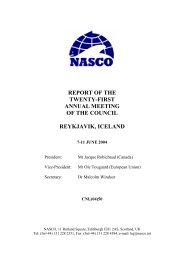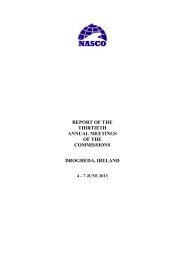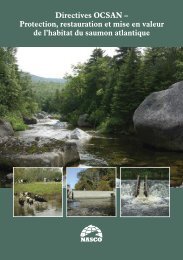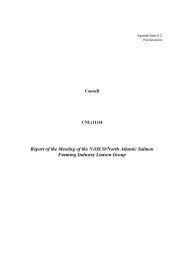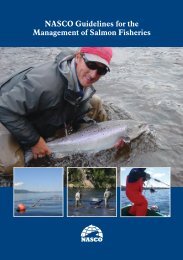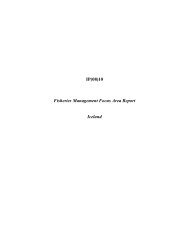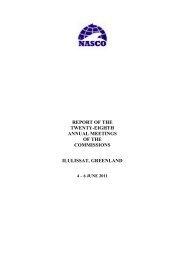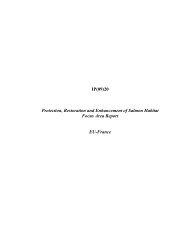Report of the 2005 ICES/NASCO Symposium on Interactions ...
Report of the 2005 ICES/NASCO Symposium on Interactions ...
Report of the 2005 ICES/NASCO Symposium on Interactions ...
Create successful ePaper yourself
Turn your PDF publications into a flip-book with our unique Google optimized e-Paper software.
NINA SPECIAL REPORT 34<br />
fish in <str<strong>on</strong>g>the</str<strong>on</strong>g> catches and, provided that <str<strong>on</strong>g>the</str<strong>on</strong>g> c<strong>on</strong>servati<strong>on</strong><br />
status <str<strong>on</strong>g>of</str<strong>on</strong>g> local wild salm<strong>on</strong>id stocks is taken into account,<br />
such a fishery may reduce <str<strong>on</strong>g>the</str<strong>on</strong>g> number <str<strong>on</strong>g>of</str<strong>on</strong>g> escapees, thus<br />
lowering <str<strong>on</strong>g>the</str<strong>on</strong>g> risk <str<strong>on</strong>g>of</str<strong>on</strong>g> introgressi<strong>on</strong> with wild salm<strong>on</strong>id<br />
populati<strong>on</strong>s and removing potential sources <str<strong>on</strong>g>of</str<strong>on</strong>g> sea lice,<br />
and provide informati<strong>on</strong> <strong>on</strong> relative abundance <str<strong>on</strong>g>of</str<strong>on</strong>g><br />
escapees in <str<strong>on</strong>g>the</str<strong>on</strong>g> sea.<br />
A third presentati<strong>on</strong> from Norway described a study, <str<strong>on</strong>g>the</str<strong>on</strong>g><br />
‘TRACES’ project, that is being c<strong>on</strong>ducted in <str<strong>on</strong>g>the</str<strong>on</strong>g><br />
Hardangerfjord to examine <str<strong>on</strong>g>the</str<strong>on</strong>g> costs and efficiency <str<strong>on</strong>g>of</str<strong>on</strong>g><br />
identifying and tracing <str<strong>on</strong>g>the</str<strong>on</strong>g> origin <str<strong>on</strong>g>of</str<strong>on</strong>g> farmed salm<strong>on</strong>. In<br />
2003, a nati<strong>on</strong>al Committee had been established in<br />
Norway to identify methods to trace <str<strong>on</strong>g>the</str<strong>on</strong>g> origin <str<strong>on</strong>g>of</str<strong>on</strong>g><br />
escaped farmed salm<strong>on</strong> and had c<strong>on</strong>cluded that no<br />
methods were ready at that time for implementati<strong>on</strong>. Two<br />
methods were, however, identified that merited fur<str<strong>on</strong>g>the</str<strong>on</strong>g>r<br />
investigati<strong>on</strong>: coded-wire tagging and a ‘c<strong>on</strong>tingency<br />
approach’ based <strong>on</strong> <str<strong>on</strong>g>the</str<strong>on</strong>g> characteristics <str<strong>on</strong>g>of</str<strong>on</strong>g> <str<strong>on</strong>g>the</str<strong>on</strong>g> fish. In <str<strong>on</strong>g>the</str<strong>on</strong>g><br />
‘TRACES’ project, DNA microsatellite markers, single<br />
nucleotide polymorphisms, fatty acid pr<str<strong>on</strong>g>of</str<strong>on</strong>g>iles, trace<br />
element and stable isotope compositi<strong>on</strong> were assessed<br />
with regard to <str<strong>on</strong>g>the</str<strong>on</strong>g>ir utility in tracing <str<strong>on</strong>g>the</str<strong>on</strong>g> farm <str<strong>on</strong>g>of</str<strong>on</strong>g> origin <str<strong>on</strong>g>of</str<strong>on</strong>g><br />
escapes.<br />
A study involving acoustic tracking <str<strong>on</strong>g>of</str<strong>on</strong>g> wild cod found that<br />
<str<strong>on</strong>g>the</str<strong>on</strong>g>y occurred in <str<strong>on</strong>g>the</str<strong>on</strong>g> exit corridors <str<strong>on</strong>g>of</str<strong>on</strong>g> wild salm<strong>on</strong> smolts<br />
from critically endangered salm<strong>on</strong> rivers in <str<strong>on</strong>g>the</str<strong>on</strong>g> Bay <str<strong>on</strong>g>of</str<strong>on</strong>g><br />
Fundy. The authors expressed c<strong>on</strong>cern that as field trials<br />
rearing farmed cod are now underway, escapees from cod<br />
farms might behave like <str<strong>on</strong>g>the</str<strong>on</strong>g> wild cod in <str<strong>on</strong>g>the</str<strong>on</strong>g>ir study, and<br />
<str<strong>on</strong>g>the</str<strong>on</strong>g>y could prey <strong>on</strong> wild salm<strong>on</strong> smolts. The authors<br />
c<strong>on</strong>cluded that <str<strong>on</strong>g>the</str<strong>on</strong>g>re is a need for careful c<strong>on</strong>siderati<strong>on</strong> to<br />
cage design and siting so as to avoid interacti<strong>on</strong>s with wild<br />
cod and with wild salm<strong>on</strong> and o<str<strong>on</strong>g>the</str<strong>on</strong>g>r diadromous species.<br />
Sea lice biology<br />
Two posters presented informati<strong>on</strong> <strong>on</strong> sea lice biology.<br />
The first examined <str<strong>on</strong>g>the</str<strong>on</strong>g> infestati<strong>on</strong> success <str<strong>on</strong>g>of</str<strong>on</strong>g> sea lice at<br />
different temperatures ranging from 6 - 16 o C and showed<br />
that lice were infectious for a l<strong>on</strong>ger period <str<strong>on</strong>g>of</str<strong>on</strong>g> time at low<br />
temperatures. These data are important in modelling <str<strong>on</strong>g>the</str<strong>on</strong>g><br />
dispersal and survival <str<strong>on</strong>g>of</str<strong>on</strong>g> free-living lice larvae.<br />
The sec<strong>on</strong>d presentati<strong>on</strong> examined <str<strong>on</strong>g>the</str<strong>on</strong>g> role <str<strong>on</strong>g>of</str<strong>on</strong>g> freshwater<br />
acidificati<strong>on</strong> <strong>on</strong> <str<strong>on</strong>g>the</str<strong>on</strong>g> sensitivity <str<strong>on</strong>g>of</str<strong>on</strong>g> salm<strong>on</strong> smolts to sea lice.<br />
Many rivers in sou<str<strong>on</strong>g>the</str<strong>on</strong>g>rn Norway can be periodically<br />
acidified to sub-lethal levels and additi<strong>on</strong>ally <str<strong>on</strong>g>the</str<strong>on</strong>g>re are<br />
many fish farms in <str<strong>on</strong>g>the</str<strong>on</strong>g> regi<strong>on</strong>. This study c<strong>on</strong>cluded that<br />
<str<strong>on</strong>g>the</str<strong>on</strong>g> combined effects <str<strong>on</strong>g>of</str<strong>on</strong>g> moderate acidificati<strong>on</strong> in fresh<br />
water and moderate sea lice infestati<strong>on</strong> in sea water can<br />
have <str<strong>on</strong>g>the</str<strong>on</strong>g> same negative effect as higher acidificati<strong>on</strong> or<br />
higher lice infestati<strong>on</strong>. The authors c<strong>on</strong>cluded that <str<strong>on</strong>g>the</str<strong>on</strong>g>re is<br />
a need, <str<strong>on</strong>g>the</str<strong>on</strong>g>refore, to c<strong>on</strong>sider <str<strong>on</strong>g>the</str<strong>on</strong>g> effects <str<strong>on</strong>g>of</str<strong>on</strong>g> multiple<br />
stressors <strong>on</strong> smolt survival ra<str<strong>on</strong>g>the</str<strong>on</strong>g>r than using single-factor<br />
models.<br />
Stocking programmes<br />
A study from <str<strong>on</strong>g>the</str<strong>on</strong>g> rivers Ulla and Lerez in Spain examined<br />
genetic variati<strong>on</strong> in <str<strong>on</strong>g>the</str<strong>on</strong>g> restored populati<strong>on</strong>s. These<br />
populati<strong>on</strong>s were close to extincti<strong>on</strong> in <str<strong>on</strong>g>the</str<strong>on</strong>g> 1990s but a<br />
restorati<strong>on</strong> programme involving habitat improvements,<br />
fishery regulati<strong>on</strong>s and a supportive breeding programme,<br />
based <strong>on</strong> native juveniles and returning adults, has been<br />
undertaken since 1995. The study indicated that modern<br />
populati<strong>on</strong>s are very similar genetically to those present<br />
prior to stocking, although <str<strong>on</strong>g>the</str<strong>on</strong>g> populati<strong>on</strong>s are more<br />
similar today than in <str<strong>on</strong>g>the</str<strong>on</strong>g> past.<br />
The C<strong>on</strong>necticut River lost its salm<strong>on</strong> populati<strong>on</strong> about<br />
200 years ago due to human activities but a salm<strong>on</strong> run<br />
has been re-established based mainly <strong>on</strong> stock from <str<strong>on</strong>g>the</str<strong>on</strong>g><br />
Penobscot River. The current genetic pr<str<strong>on</strong>g>of</str<strong>on</strong>g>ile <str<strong>on</strong>g>of</str<strong>on</strong>g> salm<strong>on</strong> in<br />
<str<strong>on</strong>g>the</str<strong>on</strong>g> C<strong>on</strong>necticut was shown to be very similar to that <str<strong>on</strong>g>of</str<strong>on</strong>g><br />
its d<strong>on</strong>or populati<strong>on</strong> in <str<strong>on</strong>g>the</str<strong>on</strong>g> Penobscot, indicating that <str<strong>on</strong>g>the</str<strong>on</strong>g><br />
effective number <str<strong>on</strong>g>of</str<strong>on</strong>g> breeders in both rivers has been large<br />
enough to preserve genetic variability and that no genetic<br />
bottlenecks occurred during <str<strong>on</strong>g>the</str<strong>on</strong>g> restorati<strong>on</strong> programme.<br />
The differences that were detected were c<strong>on</strong>sidered to<br />
be adaptive resp<strong>on</strong>ses to envir<strong>on</strong>mental variati<strong>on</strong>.<br />
A study from <str<strong>on</strong>g>the</str<strong>on</strong>g> Burrishoole River in Ireland analysed<br />
stock and recruitment data for a populati<strong>on</strong> receiving<br />
variable, but significant, quantities <str<strong>on</strong>g>of</str<strong>on</strong>g> naturally spawning,<br />
hatchery-origin fish over a thirty-five year period. The<br />
results suggest that <str<strong>on</strong>g>the</str<strong>on</strong>g> hatchery fish had a significant<br />
depressive impact <strong>on</strong> <str<strong>on</strong>g>the</str<strong>on</strong>g> recipient populati<strong>on</strong> <str<strong>on</strong>g>of</str<strong>on</strong>g> about<br />
30% and <str<strong>on</strong>g>the</str<strong>on</strong>g> author c<strong>on</strong>cluded that removal, ra<str<strong>on</strong>g>the</str<strong>on</strong>g>r than<br />
additi<strong>on</strong>, <str<strong>on</strong>g>of</str<strong>on</strong>g> hatchery fish may be <str<strong>on</strong>g>the</str<strong>on</strong>g> most effective<br />
strategy to improve productivity and resilience in wild<br />
stocks. In <str<strong>on</strong>g>the</str<strong>on</strong>g> last eight years, hatchery fish were<br />
effectively excluded from spawning in <str<strong>on</strong>g>the</str<strong>on</strong>g> wild and a<br />
significant improvement in freshwater producti<strong>on</strong> <str<strong>on</strong>g>of</str<strong>on</strong>g> smolts<br />
was observed.<br />
Aquaculture-free z<strong>on</strong>es<br />
A presentati<strong>on</strong> from Iceland reported <strong>on</strong> <str<strong>on</strong>g>the</str<strong>on</strong>g> rati<strong>on</strong>ale for<br />
<str<strong>on</strong>g>the</str<strong>on</strong>g> establishment <str<strong>on</strong>g>of</str<strong>on</strong>g> aquaculture-free z<strong>on</strong>es in wild<br />
salm<strong>on</strong>-producing areas to protect valuable salm<strong>on</strong> angling<br />
fisheries. Salm<strong>on</strong> farming is not permitted in bays and<br />
fjords with <str<strong>on</strong>g>the</str<strong>on</strong>g> most valuable salm<strong>on</strong> rivers and in <str<strong>on</strong>g>the</str<strong>on</strong>g><br />
areas where it is permitted, <str<strong>on</strong>g>the</str<strong>on</strong>g> experience gained will be<br />
13



